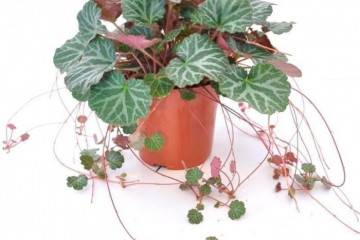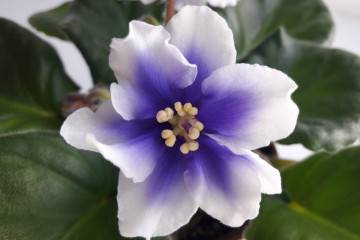Violet bridal bouquet - flower description
Content:
There are many varieties of the beloved violet. One of the brightest representatives is the “Wedding Bouquet” variety. It was bred by the breeder K. Morev. The breeder's flowers have always been distinguished by their special appearance and therefore attract the attention of all indoor plant lovers.
What does a violet "Wedding bouquet" look like?
Violet with large delicate white flowers. In the process of flowering, a white ball is formed, very similar to a bride's bouquet. The shape of the flowers resembles large stars. The reverse side has a smoky silver color. And so the whole plant appears to be in a silvery haze. When grown in a cool place, a greenish border appears along the edge of the petals.
Duration of flowering from 2 to 3 weeks. The interval is 2-3 months. There are up to 5 peduncles in the outlet. Each of them has 4 large flowers. Violet Wedding bouquet (Morev) is deservedly considered the most successful work of the breeder.
Features of care for a violet Wedding bouquet
This variety is quite unpretentious. But you still need to follow some rules for keeping violets at home, so that the flowering is complete.
The plant does not like extreme heat. At elevated temperatures, the flowers will not be crimped, but ordinary. Therefore, the optimum temperature for the growth and development of peduncles is slightly above 20 degrees Celsius. In winter, the violet rests, the ambient temperature should not exceed 18 degrees Celsius. Watering of the plant during this period is reduced.
Correct lighting is equally important. Violet does not like direct sunlight. They lead to leaf burns and overheating of the soil in the pot. But even with a lack of light, it is impossible to keep the flower. South-facing windows are not suitable for violets, and on the northern windows it will need additional lighting. Accordingly, the best solution would be to keep the houseplant in the southwest and west windows.
During the period of activity, the plant should be watered regularly so that the ground is always moist. Violet reacts equally painfully to both the lack of moisture and its excess. Therefore, watering should be regular, but the roots should not be poured in any case.
Watering uses one of three methods:
- top - watering is done directly on the soil, avoiding contact with the leaves;
- bottom - the bottom of the pot is placed in water for a time until moisture can be seen at the top of the soil;
- the wick method will provide a constant supply of moisture to the plant. One end of the wick is placed in the soil, and the other in the vessel under the pot. The flower takes as much moisture as it needs. This method is only suitable for mature plants.
Many houseplants love spraying. Violets also love to wash the leaves. But spraying should be carried out only with a very fine spray gun, so that no drops of water remain on the leaves. Subsequently, drops inside the outlet lead to decay. Many flower growers, instead of spraying, wash the leaves with water at room temperature, not allowing them to enter the outlet.
Soil for violets should be as fertile and loose as possible. It is best to buy a ready-made mixture at a store. But if there is no such possibility, then you can prepare the earth yourself. This will require 1 part of sand, 3 peat and 5 soil. A little ash is also added here and about 10% of the volume is vermiculite.
When a rosette is formed, then fertilizers should be with a high nitrogen content. During flowering, it is worth choosing fertilizers that contain phosphorus and potassium.
Violet bloom
You can endlessly describe violet flowers. The interior is dazzling white, sometimes with a green border. The flowers can reach a diameter of 7 cm. When all the buds are blooming, it seems that this is one large spherical flower.
There are two types of outlets:
- The first is with rounded leaves, a green border most often appears on such leaves. A plant with such forms is very picky about the quality and amount of moisture. With improper watering, it stops blooming.
- The second - with straight sharp leaves, less capricious. It is a spore of the main plant.
Flowering lasts about 3 weeks, the next can be expected in 2-3 months. For the beauty of violets, it is enough to follow all the rules, which include: lighting, watering and timely feeding.
Reproduction of violets Wedding bouquet
The simplest breeding method is suitable for this type of violet. It grows beautifully from a rooted leaf. You need to take a leaf in the middle row. It can be placed in water beforehand, or it can be rooted right away.
A leaf placed in water will give roots and babies in about a month. It is necessary to wait until the leaves of the children reach a size of 3 cm, and only after that they can be separated and planted in the prepared soil. It is recommended to cover the plant with a plastic cup or cut off plastic bottle after planting (to create a greenhouse effect).
Separation of the stepson is possible. Only one outlet should live in the pot, so the appeared stepchildren can be carefully separated and transplanted.
Another method, the most difficult, is seed propagation. They are pre-prepared: the seeds are mixed with charcoal and sand. Shake well. For germination, it is better to use special cassettes (phytocassettes). Seeds are planted in prepared soil, covered with lids and placed in a warm place, but without direct sunlight.
Violet transplant
After purchasing a violet wedding bouquet, you need to transplant the plant. To do this, a third of the pot is filled with drainage, and the transplant is done with a lump of native land.
When the plant reaches 3 years of age, replanting should be carried out every spring, with a complete replacement of the soil. Each year, when transplanting, the pot should be increased by 1 cm. The maximum pot should be 11-12 cm in size.
Violet Wedding bouquet and violet Bridal bouquet are the same both in care and in transplantation. But the violet Bride is distinguished by unstable varietal characteristics.
Possible problems in growing violets
Basically, all threatening plant diseases can occur from improper care. Lack of light and excessive watering can lead to the development of late blight, gray mold or powdery mildew. With high humidity, the roots of the plant rot and the plant dies.
If the disease is noticed at an early stage, then you can save the violet. It needs to be transplanted by cutting off all affected leaves. Slices must be sprinkled with crushed charcoal.
In addition to diseases, pests can attack the plant:
- aphid,
- nematodes,
- ticks.
If this happens, treating greens with special means will help get rid of parasites. Suitable for processing: Fitover, Alatar and other substances of similar action. You need to carry out the procedure at least 3 times.
It is worth noting that even beginners can cope with growing violets at home. They are quite unpretentious in care and, subject to certain rules, grow and bloom without problems. Differences in caring for a violet Wedding bouquet in comparison with other varieties are practically non-existent. Therefore, it does not matter which variety is purchased, the main thing is the correct watering, the temperature of the content and the lighting.



















